A to Z Challenge: M is for Making Amigurumi Patterns

 Once you get comfortable working up other crafter’s patterns, why not try making your own? You will begin to understand how increasing and decreasing stitches can change the shape of your piece while crocheting in the round. I made other crocheter’s patterns for about two to three years before feeling confident enough to make my own.
Once you get comfortable working up other crafter’s patterns, why not try making your own? You will begin to understand how increasing and decreasing stitches can change the shape of your piece while crocheting in the round. I made other crocheter’s patterns for about two to three years before feeling confident enough to make my own.
Fair warning: just like in writing stories, there is always revising in pattern writing and it often takes making rows and ripping them out several times before you get the shape just right. I have included a picture of my pattern writing process for you here, to illustrate what I mean. Sad to say, the center picture is not my own and has nothing to do with the pattern. I just wrote the pattern around it. The leaf is what I was working on making here.

Looks a bit scary doesn’t it? Let me just say this though, even after crossing out and reworking each piece, I eventually got it just the way I wanted it. The end result is always worth the revisions made to get there.
When you look at a character you want to make in crocheted form, the first thing you should do is break down the character into its most basic form: shapes. You will find many patterns will be made up of: circles, ovals, cylinders, half-circles, triangles, etc. Once you make the separate pieces, you will be able to give the amigurumi heart by embellishing with buttons, safety eyes, embroidered details, felt, etc, in order to bring out the character within the character.
How?
Why don’t we take a look at one of my basic patterns together? I have drawn up a very simple floppy-legged cat here:
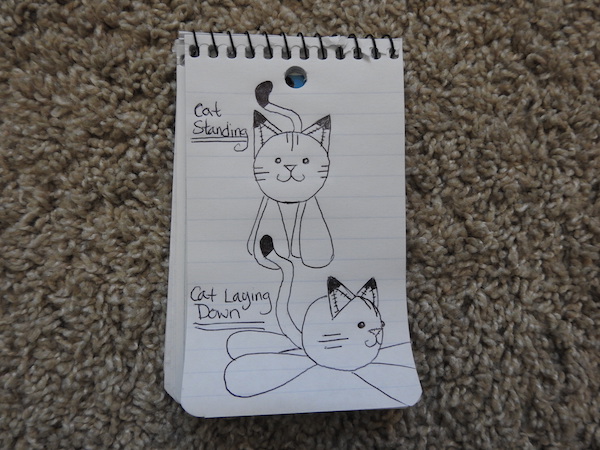
Now let’s separate this character into its basic form, picking out the shapes that make up the whole picture. Below are the kinds of sketches I draw up to do this, when I am going to be coming up with a new character.
I break up the details so that I know where I plan to embroider, use felt, add poly pellets (little plastic circles generally used to stuff the bottom of the legs or body, in order to add weight), stuffing, etc.
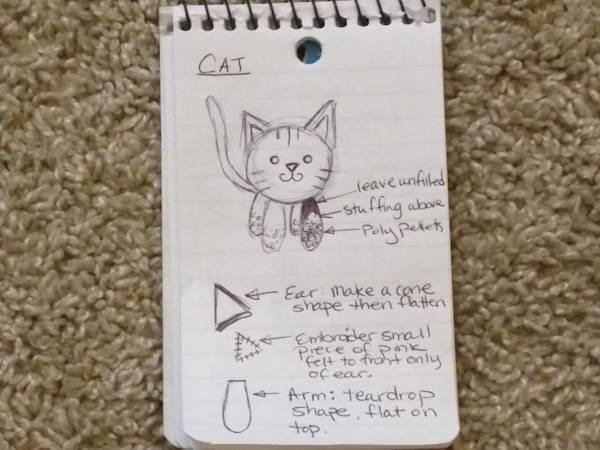
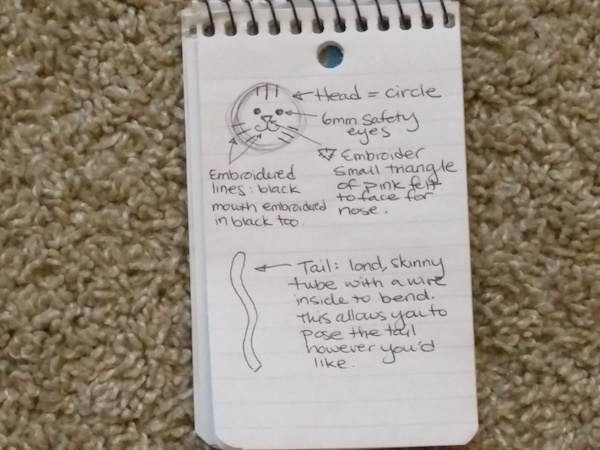
Easy so far? Not too bad right? Let’s focus in on each piece, one at a time. The head of the cat is a circle. Circles are very common in amigurumi and they are also fairly easy to make.
Making a Circle:
Often you will see patterns for circle shapes beginning with: 6sc (single crochet) in a magic ring – 6 (row ends with 6 stitches); from there, you increase in all stitches: inc around – 12; then begin the pattern: (sc, inc) around – 18; (2sc, inc) around – 24; (3sc, inc) around – 30; etc, until the head measures the circumference you want.
You can now begin single crocheting around to build up some of the height of the head. This is equivalent to more rows than you made during the increasing portion of the circle, if you’re looking to make a perfect circle. Once those are in place, you decrease (I like to use the invisible decrease technique – invdec) evenly, using the same instruction for the final increase row, except instead of increasing, you will decrease.
For example: If the last increase row was: (4sc, inc) around – 36, then your first decrease row will be (4sc, invdec) around – 30.
Make sense? Now let’s look at a flattened triangle…
Making a Flattened Triangle:
Triangles are still worked in the round. In my floppy cat pattern, the triangle is flattened for double thickness and is left unstuffed.
To get the drastic angles, you usually begin with: 4sc in a magic ring – 4. From here you will make: (sc, inc) around – 6, and continue increasing this way [(2sc, inc) around], [(3sc, inc) around, etc], until you have the triangle the size you want. This will make your triangle have three even sides. If you want them taller, but thinner, you will need to add some [sc around] rows in order to space out the increases.
This technique is one I’ve used many times and you can get different shapes this way depending on what you are looking to make. The leaves for my Happy Sunflower pattern are made in the round and then flattened. The increase and decrease stitches were made where I planned for the two edges of the leaf to be.
Making amigurumi is all about knowing when to increase and decrease.
When working your way through patterns, try to keep in mind why you’re being asked to increase or decrease at any given time. Think about the shape you are trying to make and it will all begin to make sense.
Would you like to know the thoughts behind how to make additional shapes in amigurumi? Any in particular?
Once again, I’d like to provide the link to my Giveaway post, so that you can enter to win an amigurumi crocheted dog (made by me).
Photo Credit: J.H. Winter

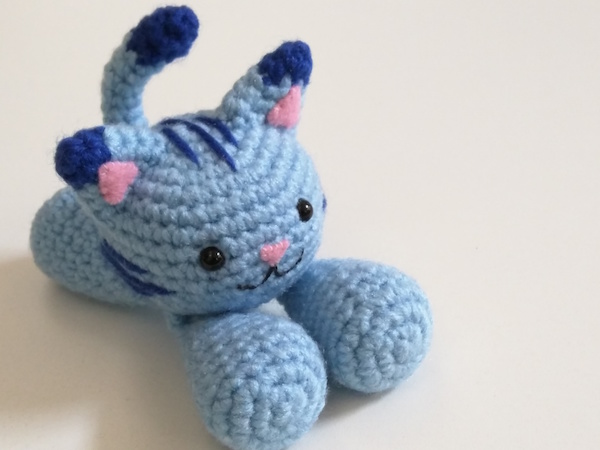
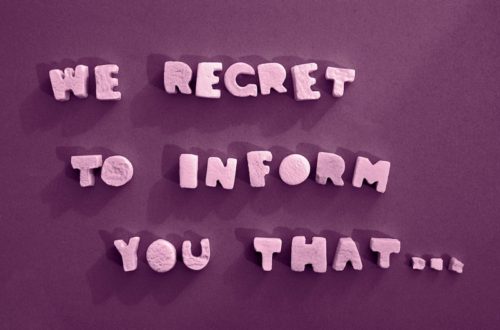
6 Comments
Ronel Janse van Vuuren
Fascinating. Knitting plain scarves is the closest I come to counting stitches 😉 I like the pics – the cat has great facial features, looks like he’s thinking of mischief. Your blog is interesting; I can’t wait to read more. Now I’m off to have coffee with my characters… Good luck with the rest of the AtoZchallenge.
JHWinter
Thank you so much! Cats are always thinking of mischief 😛 Good luck with the writing!
Jackie
That cat is so cute! Making patterns looks very complicated to me, but it must be so fun creatively to be able to make anything you’d like!
JHWinter
It is! The possibilities are endless!
Fi H
This is so adorable! I love the colours! Have always wanted to get into this but I just can’t get the hang of it :’)
JHWinter
Thank you! I have a YouTube Channel started for Ink & Stitches, and there I’m teaching how to crochet, if you are interested in taking a look! I’ll be posting more how-to videos soon!